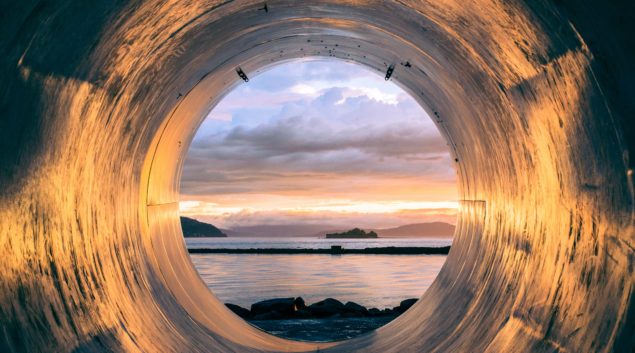
In the current linear take-make-dispose economy, most companies cannot grow without also growing their material and environmental footprint – a key barrier for reaching climate targets in time. With upcoming EU reporting requirements, this disconnect will have to be publicly disclosed, making companies more vulnerable to public and financial scrutiny.
In our recent webinar titled “Achieving Climate Targets with Circularity,” our in-house climate expert Ole Høy Jakobsen and sustainability advisor Johan Schoonhoven from Ørsted[1], shared their insights on how companies can align themselves with a better future and successfully navigate the transition to a low-carbon economy by embracing circular economy principles and the circularity hierarchy.
Transitioning to a low carbon economy requires more than an energy transition
The energy sector currently accounts for ~75% of global greenhouse gas (GHG) emissions. To address the urgent need for reducing GHG emissions in this sector, companies have been transitioning from fossil fuels to renewable energy sources. However, achieving the ambitious goal of climate neutrality by 2050, as set by the European Union, requires further action. According to the International Energy Agency (IEA), global energy demand is projected to decrease by 8% by 2050, even as the economy doubles in size and the population increases by 2 billion people. To meet these targets, businesses can enhance their current models by embracing the principles of the circular economy.
The essence of the circular economy is to create a system where no resources are lost
The circular economy focuses on creating a closed-loop system where resources are used efficiently, continuously circulated, and waste does not exist. In the circular economy, products and materials are designed to be reused, repaired, or recycled, prolonging their lifespan – reducing the need for new resources and thereby enabling long-term environmental and economic well-being. The circular economy is based on three principles:
- Design out waste and pollution at the outset
- Keep products, components, and materials in use at the highest utility and value as long as possible
- Regenerate natural systems (e.g., nature-based carbon storage)
In its simplest form, circularity removes and replaces certain processes thus cutting the emissions relating to a material. Choosing the right circularity approach is essential to reap the decarbonisation rewards of circularity.
The circularity hierarchy – Examples with ‘The Good Company’
The hierarchy of circularity consists of five essentials: Refuse, Reduce, Reuse, Remanufacture, and Recycle. Ideally, in a perfect circular economy, the concept of disposal would be eliminated.
To help illustrate the hierarchy more effectively, we have provided an example featuring ‘The Good Company’ – a company that sells chairs.
1. Recycle
Replacing virgin materials with recycled materials in the production process, offers several benefits while also presenting certain trade-offs. Besides reducing embedded GHG emissions, this approach may lead to lower costs of materials, as using recycled materials can reduce costs compared to virgin materials. Currently sourcing recyclates can also pose challenges, such as a more complex procurement process for example.
The Good Company: By replacing all virgin PET in their PET-chairs with recycled PET, The Good Company sees a combined saving of 68% of the material-related CO2 of their PET-chairs.
2. Remanufacture
Companies can establish processes to pick up products when they reach their end of life, facilitating the reuse of functioning parts and reducing the need for new parts. Offering a take-back programme and enabling a second life for products can enhance customer satisfaction and loyalty, demonstrating the company’s commitment to sustainability and responsible product lifecycle management. Such solutions would often require additional partnerships or investments into logistics, facilities and storage.
The Good Company introduces a new sales policy promising customers to take over the chairs when they reach their end of life. By doing so, they see a combined saving of 55% GHG emissions per remanufactured chair compared to new chairs with additional end of life emissions benefits.
3. Reuse
By implementing circular solutions such as take-back systems, leasing/renting models, and second-hand purchasing, companies can reintroduce entire products into their sales streams, reducing the need for sourcing and processing new materials. Additionally, reuse extends the lifespan of the products, thereby reducing the overall environmental footprint, including carbon emissions.
The Good Company introduces a new business model of renting out its chairs which quickly becomes 20% of their business in a given year. Therefore, the chair company sees a combined saving of 70% GHG emissions per chair rented out compared to their chair selling business with additional end-of-life emissions benefits.
4. Refuse & reduce
By adopting smarter and more conscious product design practices, significant benefits can be achieved through material reduction or the elimination of unnecessary materials. This approach offers lower costs of raw materials and reduces the carbon footprint and other negative environmental effects associated with production and disposal.
The Good Company: Of the total material-related GHG-emissions 80% comes from the materials of the chair itself and 20% from the packaging. The Good Company realises that they’re using 50% more packaging than they need.
The Good Company saves 10% of their total material-related CO2-emissions and sees similar savings in logistics and end of life emissions.
Circularity should be a key priority in your decarbonisation strategy
We can’t achieve ambitious climate targets through renewable energy alone – circularity is a necessity. There are many ways to introduce circular practices into your business model – the goal is to find the sweet spot with maximum benefits and minimum trade-offs.
Lifetime of an asset matters! We recognise that the longer an asset remains in operation, the more it can contribute positively to sustainability goals
***
Frequently asked questions
Q: Creating a circularity strategy – Circular economy can have different definitions across different sectors & industries. Do you have any suggestions how to define internally what Circularity is in the company, how it can be measured?
A: Circular economy is more a means than an end, i.e. it is hard to measure circularity in one metric. The definition and the selected KPIs would have to relate to your company’s sector and products or services.
To identify key performance indicators (KPIs) it is a good idea to have some at company level (e.g. resource intensity of revenue) down to product level (e.g. % of recycled/reused input, lifetime etc.).
It is recommendable to ensure that your KPIs are aligned with EU’s reporting standards (ESRS) and leading frameworks such as the Ellen MacArthur Foundation’s Circulytics and MCI.
Q: Supply chain – How can companies that do not produce physical products, but only procure them, work to reduce scope 3 emissions?
A: Select suppliers that employ green and energy efficient processes, who have low levels of waste and hazardous waste production, efficient use of resources, and high input of recycled material, refurbished parts or products – or support your suppliers speeding up that transition.
Q: Trade-offs – How do you navigate the trade-offs of circularity? e.g. climate impact of transport of components for repair?
A: One could apply life cycle assessment to understand where the threshold is.
It is also important to consider spill-over effects on other sustainability areas such as pollution, human rights etc.
Apply an agile approach, where you continuously monitor and evaluate the negative/positive effects of your efforts and adapt when needed. I.e. do not get stuck in the analysis phase.
Q: Developing take back systems – The big challenge for large global companies is to establish logistics for take back Any advice for companies starting from scratch?
A: A few of the suggestions would be:
- Start with pilots or smaller markets
- Establish partnerships with other players that already have solutions in place
- Invest/support in other players/suppliers if these do yet have the full solution or capacity to meet your need
Q: Reporting – Do you think ESRS E5 will make companies go more circular?
A: Transparency does not create change on its own – however, it is likely that ESRS E5 and the demand for linking your business model to your impacts, will increase the competitive advantage of having circular and sustainable business practises.
ESRS E5 also makes it clearer how companies should perform in relation to circularity – it is not enough to manage your waste, you shall also consider how your products and business model hinders/supports a circular economy.
[1] Ørsted is the global-leader in offshore wind power and supplies large-scale and cost-competitive offshore wind energy, onshore wind energy, and solar energy solutions.




